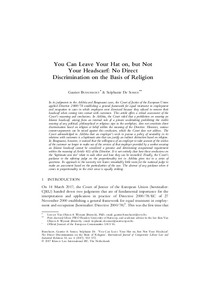You can leave your hat on, but not your headscarf: no direct discrimination on the basis of religion

Busschaert, Gautier ; De Somer, Stéphanie
The International Journal of Comparative Labour Law and Industrial Relations
2017
33
4
December
553-572
labour law ; equal rights ; religious discrimination ; EU Court of Justice ; EU law ; case law
Law
http://www.kluwerlawonline.com
English
"In its judgments in the Achbita and Bougnaoui cases, the Court of Justice of the European Union applied Directive 2000/78 establishing a general framework for equal treatment in employment and occupation to cases in which employees were dismissed because they refused to remove their headscarf when coming into contact with customers. This article offers a critical assessment of the Court's reasoning and conclusions. In Achbita, the Court ruled that a prohibition on wearing an Islamic headscarf, arising from an internal rule of a private undertaking prohibiting the visible wearing of any political, philosophical or religious sign in the workplace, does not constitute direct discrimination based on religion or belief within the meaning of the Directive. However, various counter-arguments can be raised against this conclusion, which the Court does not address. The Court acknowledged in Achbita that an employer's wish to pursue a policy of neutrality in its relations with customers is a legitimate aim that can justify an indirect distinction based on religion. In Bougnaoui, however, it warned that the willingness of an employer to take account of the wishes of the customer no longer to make use of the services of that employer provided by a worker wearing an Islamic headscarf cannot be considered a genuine and determining occupational requirement within the meaning of Article 4(1) of the Directive. It is not entirely clear how these conclusions on the ‘legitimate aim test' relate to each other and how they can be reconciled. Finally, the Court's guidance to the referring judge on the proportionality test in Achbita gives rise to a series of questions. Its approach to the necessity test leaves remarkably little room for the national judge to make an assessment based on the particularities of the case. The absence of any guidance when it comes to proportionality in the strict sense is equally striking. "
Digital
The ETUI is co-funded by the European Union. Views and opinions expressed are however those of the author(s) only and do not necessarily reflect those of the European Union or the ETUI.